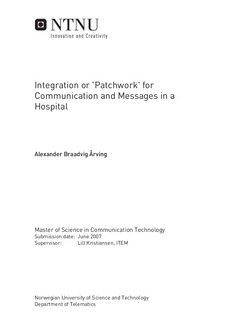Integration or 'Patchwork' for Communication and Messages in a Hospital
Master thesis
Permanent lenke
http://hdl.handle.net/11250/261934Utgivelsesdato
2007Metadata
Vis full innførselSamlinger
Sammendrag
Most research studies concerning implementation and use of ICT in hospitals relate to information systems. Various technologies and information systems are implemented in modern hospitals, such as EPRs, administrative systems, diagnostic tools, and lab systems. Common sense would suggest that collaboration for maximum efficiency would appreciate seamless integration of information systems and centralized control. Former research argues, however, that tighter integration in human-to-system communication could produce additional work or that it just relocates the workload instead of improving the efficiency and that patchworks sometimes are more beneficial than tight integration. The motivation for my research was to examine whether this strategy in hospitals would apply similarly in human-to-human communication and messaging, with a human receiver or callee . This thesis presents some former research of ICT systems in health care and explains some relevant concepts from theory. It also provides a description of the health care domain, with information about the Norwegian health sector and hospitals. My field research was conducted at different sections at the Children s Clinic at Rikshospitalet, the Norwegian national hospital. I used techniques from qualitative research (interviews and observations) to examine and evaluate communication routines and practices in the hospital. This thesis describes the most important types and technologies of communication and discusses thoughts and opinions among hospital workers on today s practices and requests for future improvements. Many hospital workers found some of today s systems and practices for human-to-human communication interruptive, rigid, and cumbersome; and some improvements and changes could be desirable. An integration of voice and text messaging in handheld devices could improve the quality of clinical communication and reduce interruptions from using pagers. It could also be beneficial with context-aware communication systems, utilizing information about location and availability. Such information could be available through integrated functionality such as a positioning system, dynamic addressbook, and calendar applications. Due to different professions and roles in a hospital, though, it is hard to find common opinions. My research indicates that administrative and office personnel seemed more interested than clinical personnel in a tighter integrated communication and coordination system. Clinicians, however, tended to be a bit more skeptical of too much integration and new technology in human-to-human communication. Important aspects of human-to-human related work are flexibility, responsibility, professional judgment, and assessment of importance; and human contact and face-to-face communication will always be necessary. When introducing new systems, it is necessary to take into consideration actual and different needs among hospital workers, information security and privacy, user-friendliness, robustness and backup, and user involvement. It is also worth bearing in mind that a hospital is an old and rigid type of organization with deep-rooted traditions, routines, and professions consisting of individualists. Improvements of communication practices and new functionality are desired and will most certainly occur as part of a modernization and digitalization process. However, hospital changes take time and must be done gradually with small steps.
